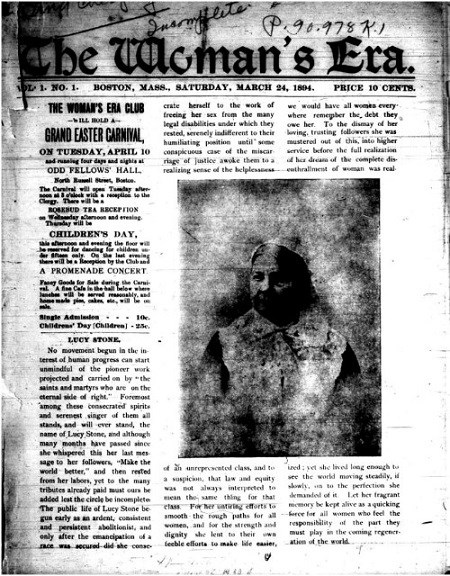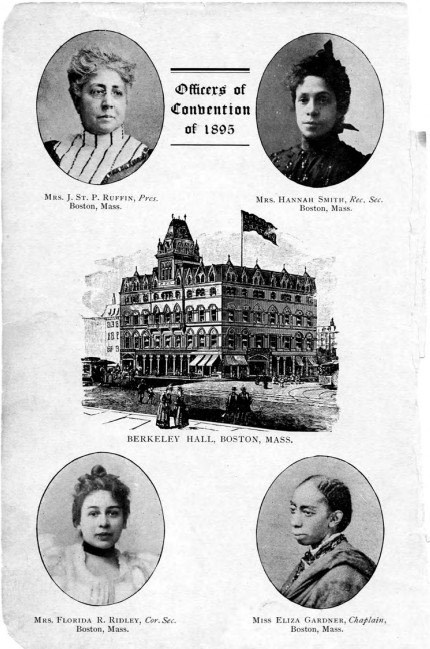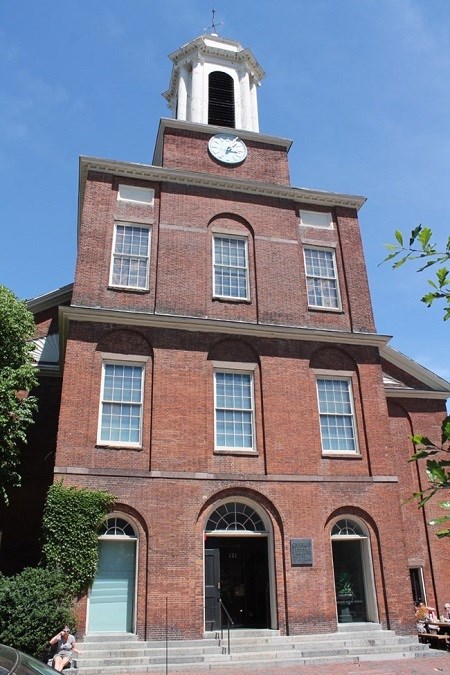Last updated: February 21, 2025
Article
"Shall We Have a Convention...?"

Rare Books and Special Collections, Boston Public Library.
A proposal for African American clubwomen to convene arose in the first issue of Boston's The Woman's Era in 1894.[1] As the first newspaper founded and edited by Black women, this monthly publication served as a means of communication for Black clubwomen across the country at a time when they found themselves largely excluded from White women's politics.[2] In the pages of The Woman's Era, Black clubwomen, including Josephine St. Pierre Ruffin and Florida Ruffin Ridley, shaped the representation of Black women by publishing their own articles on topics ranging from fiction, politics, social issues, domestic advice, and club updates.[3]
With a growing number of Black women's clubs and the birth of this nationally recognized publication, club leaders realized that a national meeting appeared to be the logical next step for advancement of the movement. For the next few months, The Woman's Era published responses from clubwomen regarding the "convention question." Nearly all seemed in agreement that the time could not be more "ripe for a convention of the colored women of the country."[4] Proponents of the convention argued that not only would a convention "lift the spirits and inspire" clubwomen to continue their work, but a national organization would "give solidity, unity of purpose, national character, and other requisites of success necessary to a movement so broad and far reaching as a race organization should be."[5]
With interest and support of a national convention established, the next task lay in deciding when and where to hold such an event. While some women wanted a meeting as soon as possible, others suggested waiting "until we are able to make such a conference impressive and grandly significant by a display of thoughtfulness, definiteness of purpose, and the presentation of facts and figures relative to work done."[6] Ultimately, a letter sent to Josephine St. Pierre Ruffin the following spring reinforced the need for Black women to unite together and prompted the immediate planning of a convention.
A Call to Confer
In March 1895, Florence Balgarnie, an English suffragist and anti-lynching advocate, received a letter from a Missouri journalist attacking Black women. In the letter, the journalist claimed Black women were "prostitutes and all are natural liars and thieves" and "wholly devoid of morality."[7] These statements appalled Florence Balgarnie, who then sent the letter to her friend, Josephine St. Pierre Ruffin. Unfortunately, this view of Black women prevailed in the South among many Whites. While The Woman's Era deemed the letter "too indecent for publication," Ruffin enclosed a copy of the letter in an invitation to Black women's clubs to finally convene. The invitation called for clubwomen across the United States to read the letter and "decide if it be not time for us to stand before the world and declare ourselves and our principles."[8]
Although the support of a national convention had previously been well established, the letter provided an extra motivation to act quickly. Clubs had to raise funds in order to send delegates to Boston, the site determined best suited for the meeting. A Missouri club stated that "never did women work more earnestly than did these slandered women to raise the money."[9] Despite having only a couple of months to raise funds and organize, Black clubwomen nevertheless sent 53 delegates representing 14 states and Washington D.C. to Boston.[10]

"A History of the Club Movement among the Colored Women of the United States of America" National Association of Colored Women's Clubs, 1902.
The Conference
The First National Conference of Colored Women of America began on July 27, 1895 at Berkeley Hall in South Boston. Following a formal opening consisting of club reports, Josephine St. Pierre Ruffin, president of the convention, delivered the inaugural address to attendees. The reasons for conferring, she declared, included the need to "feel the cheer and inspiration of meeting each other;" "to talk over not only those things which are of vital importance to us as colored women;" and, most importantly, to "teach an ignorant and suspicious world that our aims and interests are identical with those of all good aspiring women."[11] Ruffin concluded her speech by sharing her hope that by the end of the conference, a formation of a national organization would bring about a "new era to the colored women of America."[12]

Our woman’s movement is a woman’s movement in that it is led and directed by women for the good of women and men for the benefit of all humanity...we are women, American women as intensely interested in all that pertains to such as all American women; we are not alienating or withdrawing, we are only coming to the front, willing to join any others in the same work and cordially inviting and welcoming others to join us.
Image credit: New York Public Library

NPS Photo
Over three days, the conference focused on the discussion of issues such as voting rights, literature, morality, domesticity, and the work of clubwomen.[13] Notable guests delivered various speeches to the attendees. On the first day, Dr. Anna Julia Cooper spoke on the need for Black women to organize nationally. In a speech titled "The Value of Race Literature," Victoria Earle Matthews, president of The Women's Loyal Union in New York, argued more positive literature written by Black people would "be a revelation to our people, and it will enlarge our scope."[14] According to The Woman's Journal, voting rights emerged as a topic of discussion. William Lloyd Garrison Jr., son of the famous abolitionist, delivered a speech on the subject "Political Equality" and argued that the disenfranchisement of women "is the greatest barrier to universal suffrage and a proper understanding of the government by the people."[15]
A special session held on the fourth day of the conference focused on establishing a national organization. On this final day at the Charles Street A.M.E. Church, delegates created the National Federation of Afro-American Women with the objective of:
Establishing needed reforms, and the practical encouragement of all efforts being put forth by various agencies, religious, educational, ethical and otherwise, for the upbuilding, ennobling and advancement of the race; and to awaken the women of the race to the great need of systematic effort in home-making and the divinely imposed duties of motherhood.[16]
Delegates selected Margaret Murray Washington as the organization's first president.
Legacy of the Conference
As "the first movement of the kind ever attempted,"[17] the conference exceeded its goals and many considered the event a success.[18] Not only had it resulted in the creation of the National Federation of Afro-American Women (NFAW), the conference helped shape the way society viewed Black women and laid out the foundation for the advancement of the Black women’s club movement. In 1896, the NFAW and the National League of Colored Women merged their more than 100 clubs into the National Association of Colored Women, with Mary Church Terrell as President.[19] Known today as the National Association of Colored Women’s Clubs (NACWC), this organization endures and carries on the legacy of Josephine St. Pierre Ruffin. More than 100 years later, the NACWC remains an active organization with special programs, scholarships, and women’s clubs across the United States and credits Josephine St. Pierre Ruffin with laying the foundations of their mission.[20]
Contributed by Sherry Guillen, Park Guide
Footnotes:
[1] The Woman’s Era 1, no. 1 (March 1894).
[2] Teresa Blue Holden, “‘Earnest Women Can Do Anything:’ The Public Career of Josephine St. Pierre Ruffin, 1842-1904," (Phd dissertation, Saint Louis University, 2005).
[3] Katherine Fredlund, “Forget the Master's Tools, We Will Build Our Own House: The Woman's Era as a Rhetorical Forum for the Invention of African American Womanhood” (2016).
[4] The Woman’s Era 1, no. 2 (May 1894); The Woman’s Era 1, no. 3 (June 1894); The Woman’s Era 1, no. 4 (July 1894).
[5] The Woman’s Era 1, no. 2 (May 1894).
[6] The Woman’s Era 1, no.3 (June 1894).
[7] Joie-Lynn Campbell, "Just indignation: the National Association of Colored Women, from moral reformers to radical racial activists, 1895-1920s," (Thesis, Texas State University, 2013).
[8] "Historical Records of Conventions of 1895-96 of the Colored Women of America," University of Chicago Library (1902), https://www.lib.uchicago.edu/ead/pdf/ibwells-0009-006.pdf.
[9] "Historical Records of Conventions of 1895-96 of the Colored Women of America," University of Chicago Library (1902).
[10] Joie-Lynn Campbell, "Just indignation: the National Association of Colored Women, from moral reformers to radical racial activists, 1895-1920s," (Thesis, Texas State University, 2013).
[11] The Woman’s Era 2, no. 5 (August 1895).
[12] The Woman’s Era 2, no. 5 (August 1895).
[13] "Historical Records of Conventions of 1895-96 of the Colored Women of America," University of Chicago Library (1902).
[14] Victoria Earle Matthews, “The Value of Race Literature : An Address Delivered at the First Congress of Colored Women of the United States, at Boston, Mass,” (July 30th, 1895).
[15] "Colored Women's National Conference," The Woman’s Journal (August 3, 1895), Schlesinger Library, Radcliffe Institute, Harvard University.
[16] "Historical Records of Conventions of 1895-96 of the Colored Women of America," University of Chicago Library (1902).
[17] “Colored Women in Conference; National Association for Their Betterment Formed in Boston,” The New York Times (July 30, 1895).
[18] “A Brand New Sphere,” Iowa County Democrat (August 15, 1895); “Colored Women’s National Conference,” The Woman’s Journal (August 3, 1895), Schlesinger Library, Radcliffe Institute, Harvard University.
[19] Campbell, "Just indignation," (2013); Gerda Lerner, "Early Community Work of Black Club Women" The Journal of Negro History 59, no. 2 (1974).
[20] “About NACWC,” National Association of Colored Women’s Clubs, https://www.nacwc.com/history.2002
